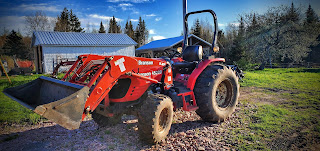Since then I spent the majority of the time just making up my own wood for the house because my equipment was pretty limited at the time. I had a chainsaw with a tractor and winch so I was limited to cutting wood that was easy to get around the fields.
Eventually, I started splitting the wood with the old splitter my grandfather had bought years ago. This was still fairly small scale and only for the house. It was a lot of work though, even for that small scale amount.
At some point, and I forget really when, I decided to try selling wood to make some additional income. Since we aren't classified as a hobby farm (hobby farms are small acreages with no intention to make income) I tried to make this an additional income stream. It was also at that point when I decided to sell the Ford Mustang we owned to purchase a truck for the farm. I started selling 1/4 of a cord orders that same year (2015).
After doing this for 3 years I decided one day to borrow a neighbors dump trailer to see how that would work to get a cord to delivery instead of 4 trips. That was a huge moment where I saw how quick it would be and home many fewer trips it would take. It was shortly after that I bought a second-hand trailer from another firewood producer to start making up wood and delivering it, a cord at a time
After one year of making about 30 cords by hand, I was exhausted. This is a lot of work to make firewood this way and it took me about 3 hours to make a cord by hand and get it into the trailer. It was around this time I started looking at firewood processors and after a demo of one at Hant Equipment, I realized it would "cut" (pun intended) my time down by 1/3 to make a load and be easier on my body. If you haven't seen one of these work, here is a link to the one I bought: https://youtu.be/30zLWx4tQdY
This was a game-changer and I saw right away why so many people in my area bought one. This allowed me to make up wood faster with less effort and even though the unit cost $25,000, it pays for it self with 2 loads a month, which is super easy! With my current set up, I'm able to do that and more without issue
I'm now doing 40-50 cords per year for sale and our own use without as much effort and much quicker. It's also been a new income stream to replace softwood (more on that in a future blog). Before buying this, it was a gamble but it paid off.
Like so many things on the farm, this was a business investment that produces income but the unknowns at the beginning of all these firewood sales made for second-guessing. I'm so glad I didn't back down because as of this blog, I'm sold out of wood and can't keep up to demand.














